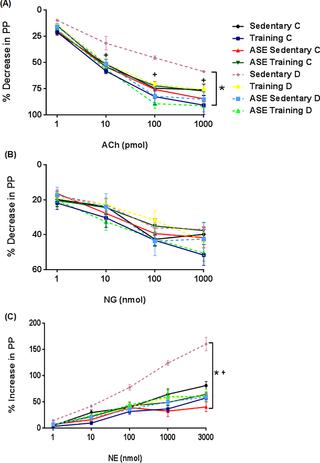PLOS ONE ( IF 3.7 ) Pub Date : 2018-06-19 , DOI: 10.1371/journal.pone.0199207 Graziele Freitas de Bem , Cristiane Aguiar Costa , Izabelle Barcellos Santos , Viviane da Silva Cristino Cordeiro , Lenize Costa Reis Marins de Carvalho , Marcelo Augusto Vieira de Souza , Ricardo de Andrade Soares , Pergentino José da Cunha Sousa , Dayane Teixeira Ognibene , Angela Castro Resende , Roberto Soares de Moura

|
A growing body of evidence suggests a protective role of polyphenols and exercise training on the disorders of type 2 diabetes mellitus (T2DM). We aimed to assess the effect of the açaí seed extract (ASE) associated with exercise training on diabetic complications induced by high-fat (HF) diet plus streptozotocin (STZ) in rats. Type 2 diabetes was induced by feeding rats with HF diet (55% fat) for 5 weeks and a single dose of STZ (35 mg/kg i.p.). Control (C) and Diabetic (D) animals were subdivided into four groups each: Sedentary, Training, ASE Sedentary, and ASE Training. ASE (200 mg/kg/day) was administered by gavage and the exercise training was performed on a treadmill (30min/day; 5 days/week) for 4 weeks after the diabetes induction. In type 2 diabetic rats, the treatment with ASE reduced blood glucose, insulin resistance, leptin and IL-6 levels, lipid profile, and vascular dysfunction. ASE increased the expression of insulin signaling proteins in skeletal muscle and adipose tissue and plasma GLP-1 levels. ASE associated with exercise training potentiated the reduction of glycemia by decreasing TNF-α levels, increasing pAKT and adiponectin expressions in adipose tissue, and IR and pAMPK expressions in skeletal muscle of type 2 diabetic rats. In conclusion, ASE treatment has an antidiabetic effect in type 2 diabetic rats by activating the insulin-signaling pathway in muscle and adipose tissue, increasing GLP-1 levels, and an anti-inflammatory action. Exercise training potentiates the glucose-lowering effect of ASE by activating adiponectin-AMPK pathway and increasing IR expression.
中文翻译:

Euterpe oleracea Mart的抗糖尿病作用。(açaí)高脂饮食和链脲佐菌素诱发的糖尿病大鼠的提取物和运动训练:正向相互作用
越来越多的证据表明,多酚和运动训练对2型糖尿病(T2DM)疾病具有保护作用。我们的目的是评估与运动训练相关的印加种子提取物(ASE)对高脂(HF)饮食加链脲佐菌素(STZ)诱导的糖尿病并发症的影响。通过给大鼠喂HF饮食(55%的脂肪)持续5周和单剂量的STZ(35 mg / kg ip),即可诱发2型糖尿病。将对照(C)和糖尿病(D)动物分为四组:久坐,训练,ASE久坐和ASE训练。通过强饲法施用ASE(200 mg / kg /天),并在诱发糖尿病后的4周内在跑步机上(30min / day; 5 days / week)进行运动训练。在2型糖尿病大鼠中,ASE治疗可降低血糖,胰岛素抵抗,瘦素和IL-6水平,脂质分布和血管功能障碍。ASE增加了骨骼肌和脂肪组织以及血浆GLP-1水平中胰岛素信号蛋白的表达。与运动训练有关的ASE通过降低TNF-α水平,增加脂肪组织中pAKT和脂联素的表达以及2型糖尿病大鼠骨骼肌中IR和pAMPK的表达来增强血糖的降低。总之,ASE治疗通过激活肌肉和脂肪组织中的胰岛素信号通路,增加GLP-1水平和抗炎作用,在2型糖尿病大鼠中具有抗糖尿病作用。运动训练可通过激活脂联素-AMPK途径并增加IR表达来增强ASE的降糖作用。ASE增加了骨骼肌和脂肪组织以及血浆GLP-1水平中胰岛素信号蛋白的表达。与运动训练有关的ASE通过降低TNF-α水平,增加脂肪组织中pAKT和脂联素的表达以及2型糖尿病大鼠骨骼肌中IR和pAMPK的表达来增强血糖的降低。总之,ASE治疗通过激活肌肉和脂肪组织中的胰岛素信号通路,增加GLP-1水平和抗炎作用,在2型糖尿病大鼠中具有抗糖尿病作用。运动训练可通过激活脂联素-AMPK途径并增加IR表达来增强ASE的降糖作用。ASE增加了骨骼肌和脂肪组织以及血浆GLP-1水平中胰岛素信号蛋白的表达。与运动训练有关的ASE通过降低TNF-α水平,增加脂肪组织中pAKT和脂联素的表达以及2型糖尿病大鼠骨骼肌中IR和pAMPK的表达来增强血糖的降低。总之,ASE治疗通过激活肌肉和脂肪组织中的胰岛素信号通路,增加GLP-1水平和抗炎作用,在2型糖尿病大鼠中具有抗糖尿病作用。运动训练可通过激活脂联素-AMPK途径并增加IR表达来增强ASE的降糖作用。与运动训练有关的ASE通过降低TNF-α水平,增加脂肪组织中pAKT和脂联素的表达以及2型糖尿病大鼠骨骼肌中IR和pAMPK的表达来增强血糖的降低。总之,ASE治疗通过激活肌肉和脂肪组织中的胰岛素信号通路,增加GLP-1水平和抗炎作用,在2型糖尿病大鼠中具有抗糖尿病作用。运动训练可通过激活脂联素-AMPK途径并增加IR表达来增强ASE的降糖作用。与运动训练有关的ASE通过降低TNF-α水平,增加脂肪组织中pAKT和脂联素的表达以及2型糖尿病大鼠骨骼肌中IR和pAMPK的表达来增强血糖的降低。总之,ASE治疗通过激活肌肉和脂肪组织中的胰岛素信号通路,增加GLP-1水平和抗炎作用,在2型糖尿病大鼠中具有抗糖尿病作用。运动训练可通过激活脂联素-AMPK途径并增加IR表达来增强ASE的降糖作用。ASE治疗通过激活肌肉和脂肪组织中的胰岛素信号通路,增加GLP-1水平和抗炎作用,在2型糖尿病大鼠中具有抗糖尿病作用。运动训练可通过激活脂联素-AMPK途径并增加IR表达来增强ASE的降糖作用。ASE治疗通过激活肌肉和脂肪组织中的胰岛素信号通路,增加GLP-1水平和抗炎作用,在2型糖尿病大鼠中具有抗糖尿病作用。运动训练可通过激活脂联素-AMPK途径并增加IR表达来增强ASE的降糖作用。



























 京公网安备 11010802027423号
京公网安备 11010802027423号